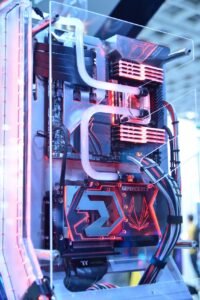
A plastic prototype is a tool or method used for the development of exact physical models of plastic products. They are identical to the expected finished product and are used to analyze flaws and improvements needed to be done in the final project.
A wide range of tools and methods are used to create three-dimensional identical models of the project. Engineering plastic e.g. acrylics, POM, polycarbonate, nylon or ABS are used to make a supposed model of a product. Their main purpose is project approval or improvement. Plastic prototyping uses additive fabrication technology. The CAD or computer-aided design data is used to make a representable model such as 3D printing, vacuum casting or CNC.
There have been so many technological advances over the last decades. It gave professionals so many choices to choose from. No matter if the whole project has to be made from scratch or only a small part is needed, there are many options to choose the best from. Let’s talk about some of the top choices in detail and discuss their pros and cons.

3D Printing
3D printing is the most popular and advanced technique in the industry. The project ends up almost identical and up to expectations. It has many advantages:
- Early and quick prototypes
- Cost-effective
- High-resolution print
- Portable
However, it has some disadvantages as well:
- Not as strong as injection-molded parts
- The cost gets higher with the length and dimensions of the project
- Parts can be fragile
- Limitations depend upon the type of material used
Rapid Prototypes
Rapid prototyping creates a 3D model from CAD fairly quickly than the other prototyping methods, hence the name rapid. It makes the whole process quicker and easier. Aluminum molds are used in the process of rapid prototyping. They are better and quicker compared to steel. They are more precise and strong the 3D printed models. However, the results cannot be 100% accurate and changes might be needed for the end product. This limitation can cause a cost increase. For these reasons, rapid molding or prototyping is considered perfect for early developmental stages but not for fully functioning parts. The types of rapid prototyping include:
- Fused Deposition Modeling (FDM),
- Stereo-lithography (SLA)
- Selective Laser Sintering (SLS).
Some quick advantages and disadvantages are as follow:
Advantages:
- Quick results
- Cheaper than 3D printing
- Testing is available at different stages
Disadvantages:
- Not every feature is as accurate as of the design
- Materials and textures have limitations
- Engineering support is very less
Production Quality Prototypes
These prototypes are used to create the models of the final and finishing parts of the design. They take care of all the limitations and errors before the designs go into industrial production. The molds of production quality prototypes are different than the other prototypes i.e. steel molds instead of aluminum molds. It helps the engineering department to analyze and test the final design, shape, form, material, flaws and functionality before the industrial mass production. It lessens the risk of ill-functioned industrial designs.
Advantages:
- No compromise on specifications, very precise results
- The exact industrial material can be used
- Parts can be replicated for massive testing circumstances
- Much stronger than the other prototyping techniques
- Used as a final stop to approve a model and design
- Early identification of the shrinking/contraction risk of the material
Disadvantages:
- Slower process than 3D printing
- Cost can increase depending on the quality and form of materials in mass production.
Now let’s discuss rapid prototyping in detail because it is the most common technique compared to others.
Rapid prototyping involves a bunch of procedures to rapidly create a 3D model of the product aka the prototype. These models are demonstrative and functional. They are made of silicone rubber.
Main functions of Rapid prototyping:
Rapid prototyping makes different versions of the same prototype for the manufacturers to test and check results for a final and sustainable design. The prototypes are cheaper to make and use. These prototypes can be experimented with fearlessly to get a perfect product as result. This help0 the manufacturers not lose their revenue by making a bad product n the basis of only the rough draft and assumptions. They are especially very useful in case of new products and ideas being launched.
The CAD programs are used in the process of rapid prototyping, even if te doesn’t have the correct shape and rough design, the rapid prototyping can fix the errors themselves.
How can you check the accuracy of your prototypes?
There are mainly two things involved to check the level of accuracy for your plastic prototype.
- The feasibility of attaining different versions of the same model i.e. modifications
- The creation of the final project master plan via CNC or computer numerical control
The CNC-made final model is known as the tooling master. It is used to create many different modified versions of the same prototype i.e. the master copies.
Rapid Plastic prototype and your pockets:
There are many benefits of plastic prototyping before actual industrial manufacturing in terms of cost and budget. Some of these are given below:
- It helps to lessen the manufacturing time and cost
- It helps to create the exact product as designed
- The actual product result is the same as the computer design
- It gives freedom of expression to engineers and designers to make multiple versions of a product to test and choose the best
- Traditional methods of making the whole industrial product will be much higher in cost than working plastic prototypes
- It helps you to achieve your dream design in even a low budget
- It helps to erase the poorly or badly designed parts to be replaced by working and good parts
- It opens new ways of experimentation.
- It makes you tension free of your money going to get wasted on a large amount of not working products, even if the initial design seemed perfect.
- It helps to make far more complicated designs that were once only imagined
It is making the impossible possible and giving way to even more advanced technology. It has become the future of industrial goods.
#Prototypes
#Polycarbonates
#Plastic prototyping
#Polycarbonate sheets

